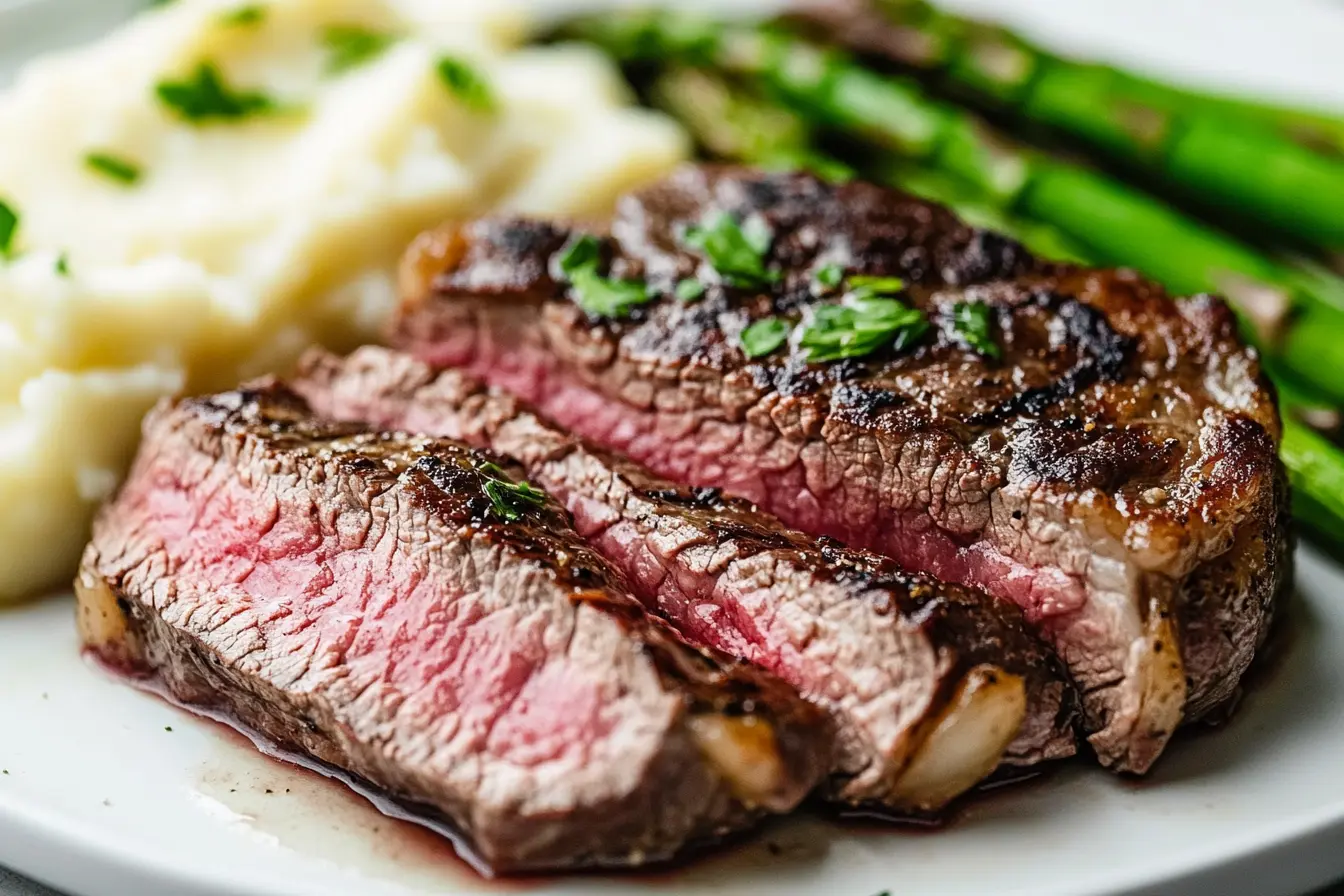Introduction to Arm Steak
Arm steak, a cut often overlooked, can be incredibly delicious when cooked correctly. This guide explores the best methods to cook arm steak, ensuring you achieve tender and flavorful results every time. We will delve into various techniques such as grilling, pan-searing, braising, and slow cooking. Additionally, we will cover essential preparation steps, common mistakes, and tips to enhance the flavor of your arm steak. Therefore, you will be well-equipped to master this often-underestimated cut of beef.
Understanding Arm Steak
What is Arm Steak?
Arm steak, also known as chuck arm steak, is a cut of beef taken from the shoulder area of the cow. Because it is from a well-used muscle, arm steak has a good amount of connective tissue. This makes it a flavorful cut. However, it can be tougher than other steaks. Consequently, proper cooking techniques are essential to maximize its tenderness and flavor.
Arm Steak vs. Other Cuts
Arm steak is different than tender cuts like ribeye or tenderloin. These cuts are generally more expensive. Conversely, arm steak is more affordable. Additionally, it has more connective tissue and requires longer cooking times for tender results. Compared to other chuck cuts, such as the chuck roast, arm steak is often cut thinner, making it suitable for quick cooking methods, as well as slow-cooking techniques. Therefore, choosing arm steak provides both flavor and value.
Nutritional Value of Arm Steak
Arm steak is a good source of protein, iron, and B vitamins. Also, like other beef cuts, it contains zinc, phosphorus, and selenium. According to the USDA, a 3-ounce serving of lean arm steak provides about 25 grams of protein. Consequently, including arm steak in your diet can contribute to overall health and nutrition. Furthermore, this protein can aid in muscle repair and growth. For more detailed nutritional information, you can visit the USDA Food Composition Database.
Preparing Arm Steak for Cooking
Selecting the Right Arm Steak
Firstly, look for arm steaks that are bright red. This indicates freshness. Additionally, the steak should have good marbling (streaks of fat within the muscle). Marbling adds flavor and keeps the steak moist. Avoid steaks that look dull, brown, or have a foul odor. Moreover, aim for steaks that are about ¾ to 1 inch thick, as this thickness works well for various cooking methods.
Proper Trimming Techniques
Before cooking, trim any excess fat from your arm steak. While some fat is desirable for flavor, large amounts of fat can cause flare-ups when grilling. Additionally, remove any silver skin (tough connective tissue). This will improve the texture of the cooked steak. Simply use a sharp knife to trim away these unwanted parts. Furthermore, trimming helps ensure that the seasonings penetrate evenly.
Marinating for Flavor and Tenderness
Marinating arm steak is a great way to enhance flavor. It also helps tenderize the meat. Therefore, use an acidic marinade such as one containing lemon juice, vinegar, or wine. Add herbs and spices like garlic, thyme, and black pepper for extra flavor. Marinate the steak for at least 30 minutes, or preferably several hours, in the refrigerator. For more marinade ideas, check out this guide from Serious Eats.
Bringing Steak to Room Temperature
Before cooking, take your arm steak out of the refrigerator. Let it sit at room temperature for about 20 to 30 minutes. This will help the steak cook more evenly. Cold steak can take longer to cook, which can result in an unevenly cooked exterior and interior. Therefore, this step is important for achieving the best results.
Best Methods to Cook Arm Steak
Grilling Arm Steak
Preparing the Grill
Firstly, ensure your grill is clean and preheated to medium-high heat. Oil the grates to prevent sticking. This will also help achieve those beautiful grill marks. Therefore, proper grill preparation is crucial. For gas grills, use medium-high heat. For charcoal, wait until the coals are covered in a white ash.
Grilling Techniques for Arm Steak
Place the arm steak directly on the hot grates. Sear each side for about 3 to 5 minutes. This creates a nice crust. Reduce the heat to medium. Continue grilling until the steak reaches your desired level of doneness. Additionally, do not overcrowd the grill. This can lower the temperature and lead to steaming instead of searing.
Achieving the Perfect Sear
A good sear is essential for a flavorful arm steak. Do not move the steak too early. Allow a crust to form. This requires patience and high heat. Use tongs to flip the steak. Avoid piercing it with a fork. Piercing can release juices and dry out the meat. Therefore, a good sear is crucial for a juicy steak.
Internal Temperature and Doneness
Use a meat thermometer to check the internal temperature. The USDA recommends an internal temperature of 145°F for medium-rare. For medium, aim for 160°F. For well-done, the temperature should be 170°F. Remember that the steak will continue to cook slightly as it rests. For more information on steak temperatures, check this guide from the American Meat Science Association.
Pan-Searing Arm Steak
Choosing the Right Pan
Use a heavy-bottomed skillet, preferably cast iron. A cast iron pan retains heat well. This helps create a good sear. However, other heavy pans can also work well. Therefore, a good pan is essential for perfect searing.
Searing Techniques for Arm Steak
Heat the pan over medium-high heat. Add a tablespoon of oil or butter. Once the pan is hot, add the arm steak. Sear each side for 3 to 5 minutes, creating a nice crust. Do not overcrowd the pan. Cook in batches if necessary. This ensures a proper sear.
Adding Aromatics
After searing, add aromatics such as garlic, thyme, or rosemary to the pan. Baste the steak with the pan drippings. These aromatics infuse the steak with extra flavor. This step is important for adding depth to the taste.
Finishing in the Oven
If the arm steak is thick, it can be finished in the oven. Preheat the oven to 350°F. Transfer the pan to the oven. Cook until the steak reaches your desired level of doneness. This technique allows for even cooking throughout the steak.
Braising Arm Steak
Selecting the Right Braising Liquid
Braising involves slow-cooking the arm steak in liquid. Use flavorful liquids such as beef broth, red wine, or a combination of both. Adding vegetables like onions, carrots, and celery will enhance the flavor. Therefore, the braising liquid is a key component.
Braising Process and Technique
First, sear the arm steak in a Dutch oven. Then, remove the steak. Sauté the vegetables. Deglaze the pot with the braising liquid. Add the steak back to the pot. The liquid should come about halfway up the side of the steak.
Tips for Tender Results
Cover the pot tightly and cook in a preheated oven at 325°F for about 2 to 3 hours. The meat should be fork-tender when done. Braising breaks down the connective tissue, making the arm steak exceptionally tender. Therefore, patience is key for tender results.
Serving Suggestions for Braised Arm Steak
Serve braised arm steak with the braising liquid poured over it. Mashed potatoes, polenta, or crusty bread make great accompaniments. The tender meat and flavorful sauce are a perfect combination. Accordingly, a variety of sides will enhance the meal.
Slow Cooking Arm Steak
Preparing for Slow Cooking
Slow cooking is another excellent method for arm steak. Before slow cooking, sear the steak on all sides in a hot pan. This adds flavor and texture. This step is optional but highly recommended. Then, transfer the seared steak to your slow cooker.
Optimal Slow Cooking Time and Temperature
Add your preferred liquid and seasonings to the slow cooker. Cook on low heat for about 6 to 8 hours. Alternatively, cook on high heat for 3 to 4 hours. The longer the cooking time, the more tender the steak will be. Therefore, low and slow is generally best.
Serving Options for Slow Cooked Arm Steak
Slow-cooked arm steak is great for making sandwiches, tacos, or stew. The meat will be incredibly tender and easy to shred. Shred the meat and serve with your favorite toppings or sauces. It’s also perfect with a variety of side dishes.
Common Mistakes to Avoid When Cooking Arm Steak
One common mistake is not allowing the steak to come to room temperature. Another mistake is not properly trimming the steak. Overcooking is another issue that can make the steak tough and dry. Furthermore, not searing the steak properly can result in a less flavorful outcome. Lastly, failing to rest the steak after cooking is detrimental. Therefore, it’s vital to avoid these mistakes.
Tips for Enhancing Flavor
Seasoning Techniques
Season arm steak generously with salt and freshly ground black pepper. Use other herbs and spices like garlic powder, onion powder, paprika, and thyme. Season the steak before cooking. Season again after cooking. Accordingly, seasoning is crucial for enhancing the flavor.
Sauces and Marinades
Use sauces and marinades to elevate the flavor of your arm steak. Try a chimichurri sauce, a red wine reduction, or a simple garlic butter sauce. Marinades help tenderize the steak while adding flavor. Therefore, sauces and marinades are excellent additions.
Serving Suggestions
Serve arm steak with complementary sides. Roasted vegetables, mashed potatoes, or a fresh salad work well. Consider the cooking method when planning your sides. For instance, a braised steak pairs well with creamy polenta. Therefore, consider sides that enhance the overall meal.
Conclusion
In conclusion, arm steak, while often underrated, can be incredibly delicious when cooked correctly. We have explored various methods, including grilling, pan-searing, braising, and slow cooking. Understanding how to properly prepare and cook arm steak will allow you to create tender and flavorful meals. By following the guidelines and tips, you can confidently cook this versatile cut of beef and enjoy it with friends and family. Therefore, mastering the art of cooking arm steak will broaden your culinary repertoire.
Frequently Asked Questions (FAQs)
What is arm steak?
Arm steak, also known as chuck arm steak, comes from the shoulder area of the cow. It’s a flavorful but tougher cut of beef.
How do I make arm steak tender?
Marinating, slow cooking, or braising will make arm steak tender. Proper trimming also helps.
What is the best way to grill arm steak?
Grill arm steak over medium-high heat. Sear both sides well. Check for your desired level of doneness using a meat thermometer.
Can I pan-sear arm steak?
Yes, pan-searing arm steak is a great method. Use a heavy-bottomed skillet and sear both sides for a perfect crust.
How long should I braise arm steak?
Braise arm steak for about 2 to 3 hours at 325°F. The meat should be fork-tender.
Can I slow cook arm steak?
Yes, slow cooking arm steak on low for 6-8 hours will result in tender, flavorful meat.
What is the best internal temperature for arm steak?
The USDA recommends 145°F for medium-rare, 160°F for medium, and 170°F for well-done.
Do I need to marinate arm steak?
Marinating enhances flavor and helps tenderize the meat, but it’s not always essential.
Should I rest arm steak after cooking?
Yes, resting the steak for 5-10 minutes allows the juices to redistribute, resulting in a more tender and flavorful steak.
What are good side dishes to serve with arm steak?
Roasted vegetables, mashed potatoes, or fresh salads complement arm steak well.

